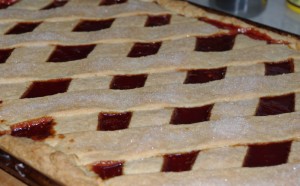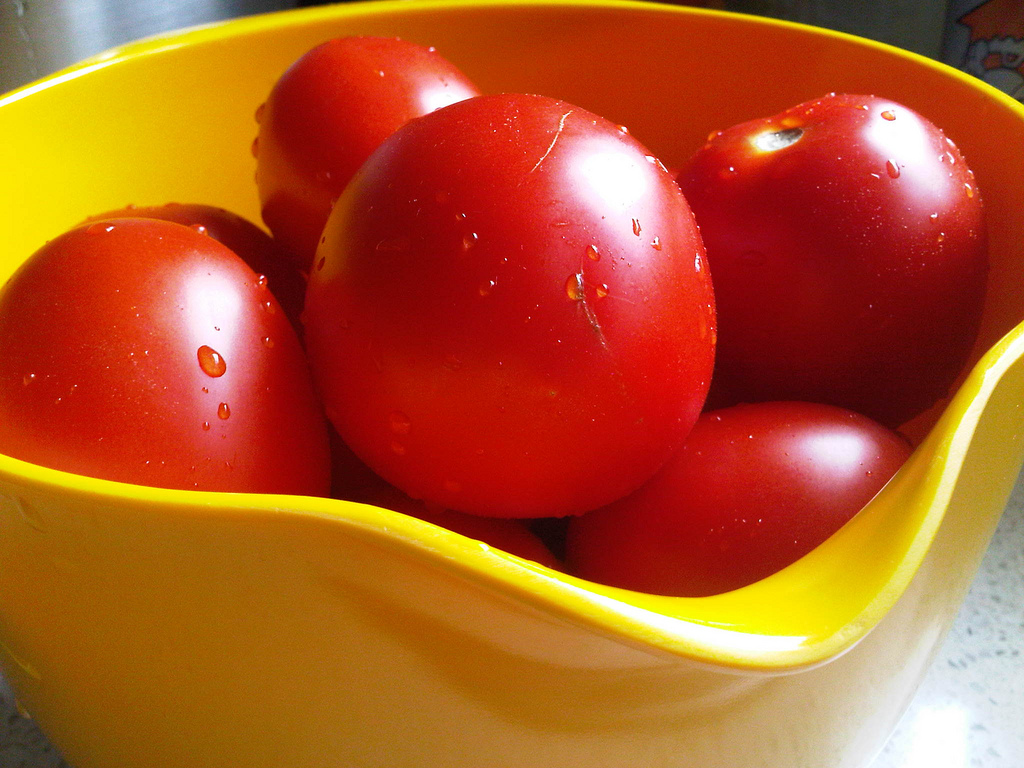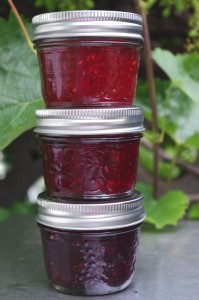The recipe for this is fairly simple: Tomatoes are a fruit, so here are the general ratios I use for non-recipe fruit preserves:
For every 1 lb fruit (tomatoes in this case) add:
1/2 cup sugar
1 T citrus juice
spices to taste
splash of liquor of your choice for additional flavour if you with at the end.
cook at a simmer for at least 1 hour, or longer until the jam reaches the set point (220 degrees on a digital thermometer, or passes jelly test on a cold plate)
In this case, I had about 6 lbs of tomatoes, cut in large dice — this included a hodge-podge mix of paste tomatoes and various cherry tomatoes from the garden. You also want to KEEP the seeds in the mix for this. The gelatinous structure around the seeds will exude a lot of juice which needs to be cooked down, BUT adds incredible umami flavour to the end product. If you're looking to make a more refined-looking product, take the skins off. I left them on for this batch.
So, for this batch:
- 6 lbs tomatoes
- 3 cups sugar (given the long cook time for this, stick with white sugar rather than brown, which will cook too quickly and taste burnt)
- 6 T lime juice (lemon will provide a sharper flavour note)
- 2 tsp cinnamon
- 1/2 tsp cloves
- 1/2 – 1 tsp cayenne pepper
Method: Combine everything in a large Dutch oven, and bring just to a boil. Turn down to a simmer and cook for 90 minutes, stirring occasionally (more frequently towards the end) until the jam reaches the desired consistency and/or set point (220 degrees F). Remove from heat, place in jars and process in a hot water canner if desired.
While this jam is sweet, the umami nature of the tomatoes make this slightly savoury at the same time, and a great addition to your charcuterie or cheese plates, or as a nice alternative to ketchup on your next burger!
]]>Last week, we had an impromptu family dinner, and I pulled together a giant crostata (11' x 17") in a large cookie sheet. Crostata is pretty simple, an Italian tart: crust on the bottom, lattice on the top, and cooked fruit in the middle. A quickfire solution for getting that fruit filling into your crostata without busting out another pot to wash, is to dip into your stash of homemade preserves.
For a large crostata, you will need approximately enough dough for 2 double crusted pies, and one 500 ml jar of jam! This version happened to be apricot-loganberry.
My favourite recipe for pasta frollo comes from my dog-eared copy of Baking with Julia (just as good now as it was in 1996!), but you can use whatever lightly sweet pastry dough you prefer. Don't forget that you can make pastry in advance and keep in the freezer
Assemble with pastry on the bottom, 500 ml of jam spread evenly on top of the pastry, and pastry lattice on top. Bake at 375 degrees for 35-45 minutes. If you want to get fancier, brush the top with egg wash and sprinkle with granulated sugar. Let it cool before cutting and serving.
That's it!
]]>
Red tomatoes in a yellow bowl
]]>
 Because there can never be enough pie in this world …
Because there can never be enough pie in this world …
Somtimes, when cooking for clients, some some creativity and trial and error in order to come up with recipes that meet their specific dietary needs, and I end up learning something in the process! Case in point, a client with a number of food issues has had a craving for chicken pot-pie — specifically pastry and chicken gravy — after many years of avoiding it due to issues with gluten, rice, potatoes, eggs, and dairy.
…So the challenge was, not so much the gravy, for which cornstarch or tapioca starch would do, in a pinch, but around the pastry., for which I normally rely on a tried and true recipe that is brown-rice flour based. The brown rice flour adds texture, flavour and nutritional value, and is rounded out by tapioca starch and potato starch, and uses an egg for binder and moisture for best results. I have seen (and tested) many recipes for mainly starch-based pastry, but found the texture too smooth for my liking, and too bland to stand up to savoury fillings.
So after a few tweaks to the old standby (amaranth to the rescue!!!) the resulting piecrust turned out to be better than my previous version! so much so, that I think I will be adopting this as the new "standard".
It converts to a sweet pie crust with the addition of a couple of tablespoons of sugar, if that's your thing. If you want to use egg as binder to make it easier to roll out, just whisk the egg first and use in place of the water. If you prefer butter, go ahead and use it in place of the shortening — this recipe was made to be egg and dairy-free, but butter works equally well.
Some of the things that work well in this recipe are the inclusion of tapioca starch to add a bit of chew and binding, cornstarch to promote crispness on the exterior, and amaranth flour to add flavour, texture, nutritional value and also promote browning (nothing is worse than a pallid pie-crust!!!). Finally, a little bit of baking powder helps "lift and separate" the flaky layers.
I tested this out late last night with cherry pie filling, and you can see it stands up quite well to moist fruit pie fillings. It can be sweetened, but works quite well unsweetened with both sweet and savoury fillings.
As with any pie crust, be sure to let it rest in the fridge for at least 30 minutes — overnight is better, to allow the flours and xantham gum to fully hydrate. Roll it out carefully, as it will be stickier than wheat-based pastry, in between layers of plastic wrap or parchment, with lots of flour (I used amaranth flour), and make sure to let it chill before you bake it to avoid having droopy edges.
]]>Gluten-free pie crust remix
(makes 1 double pie-crust)
- 2/3 cup amaranth flour
- 2/3 cup tapioca starch
- 2/3 cup cornstarch
- 1 tsp. baking powder
- 1 Tbs. xantham gum
- 1 tsp. salt
- 1 cup vegetable shortening (Earth Balance buttery sticks) OR butter, cold and cut in small pieces
- 2 tsp cider vinegar
- up to 1/2 cup ice cold water OR 2 eggs
Combine all the dry ingredients in a medium bowl and whisk well to combine. Cut in the shortening (or butter) with a pastry cutter, until the butter is no bigger than the size of small peas. Combine the vinegar and water (or eggs) and add slowly to the flour/shortening mixture, just until the pastry comes together and forms a ball when squeezed.
Form into a ball, and wrap in plastic wrap and let the pastry rest at least 30 minutes, or overnight. (you can also freeze the dough at this point)
Roll out the dough on a silpat mat, or between two pieces of plastic wrap or parchment paper, with a liberal dusting of amaranth flour.
Use in your favourite pie recipe!
With summer being so late to arrive this year (June and July were disgusting!!! no other word for it! wet, dark, and gross!!), the end result was that when the sun did finally show its face towards the end of July, everything came ripe all the same time! Strawberries, cherries, and now the bramblefruits. A few such as the boysenberries and loganberries have suffered due to the inclement weather — meaning that when I got the chance at a flat or two, I jumped on it!!!
Now bramblefruits are one of my favourite summer delights! BUT they are delicate and tempermental — leave them overnight, and they turn into a sodden mess, buzzing with fruit flies — ergo, all my canning efforts involving these little dainties are same day endeavours.
Sorry, no recipes here — all the preserves I have made thus far (52 litres and counting) have been on the fly. A couple of guidelines: for no-added pectin jams, I chop and cook fruits with skins (such as cherries or apricots) before adding any sugar. For every 1 c fruit, add 3/4 c sugar, some lemon juice and cook to 220 F. For those with added pectin, I prefer Pomona's – the set is more natural. Just follow the directions in the packet to make up your own recipes. Mine thus far have been moderately sweetened, except one batch of very low-sugar raspberry that will probably make its way into various savoury sauces over the winter.
Today's batches include: (top to bottom in the picture)
- apricot/raspberry
- loganberry/lime
- boysenberry
Running tally of preserves done up thus far this summer:
- Classic strawberry preserves with Herbs de Provence
- Cherry preserves with Lovage and Cherry Heering
- Cherry chutney
- Blueberry relish
- Apricot jam with Tugwell Creek mead
- Apricots in syrup
- Raspberry/apricot jam
- Low sugar raspberry jam
- Loganberry jam
- Loganberry/lime jam
- Boysenberry jam
if you are intersted in preserving a little bit of summer — give it a shot! Its easy to do up small batches, and if you are worried about processing in the canner, you can always keep your smaller batches in the fridge.
As the vegetables start coming on, we'll be moving onto more savoury ventures here like pickles, chutneys and relishes, and canned peaches are in our near future!
]]>

